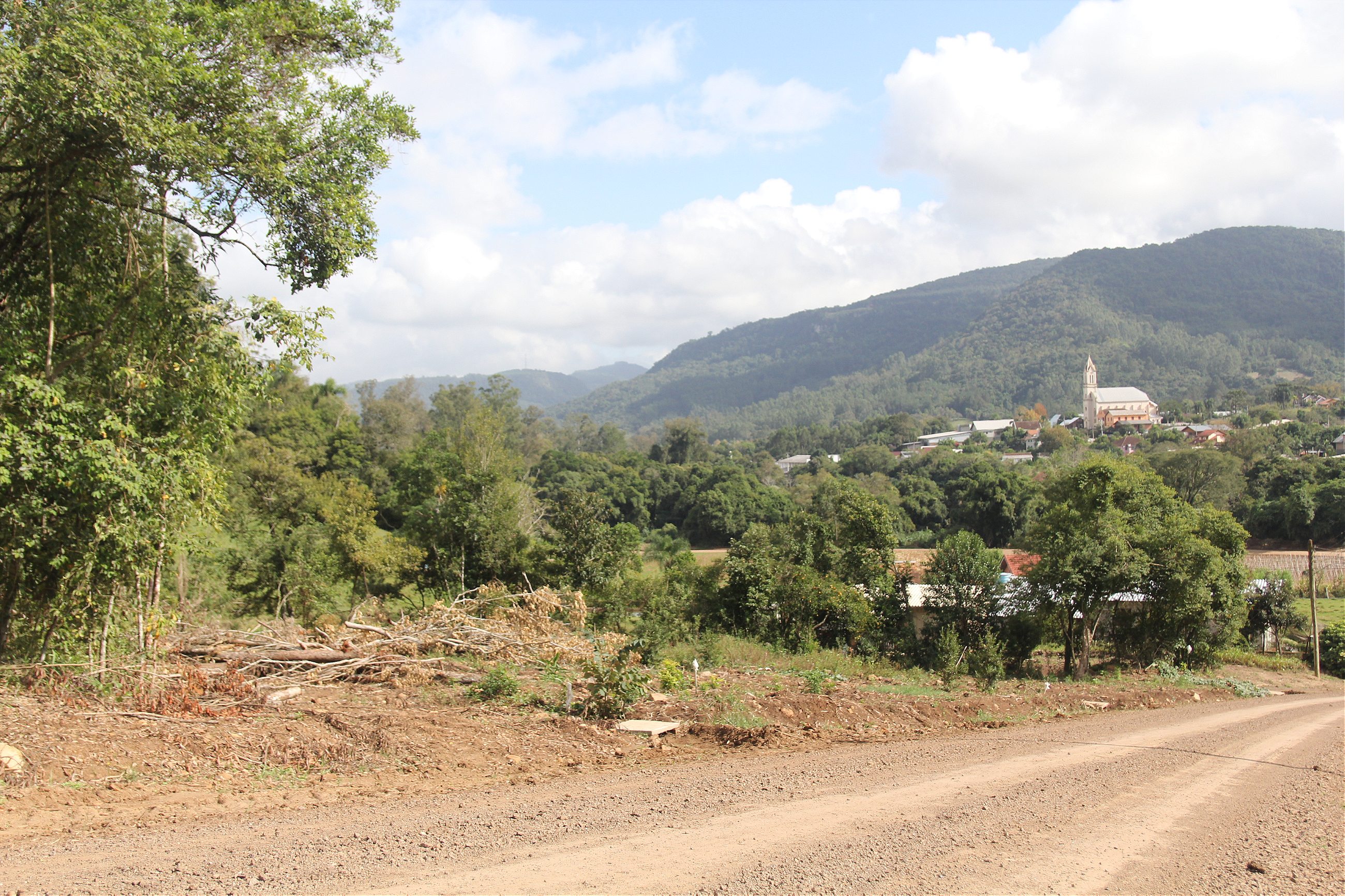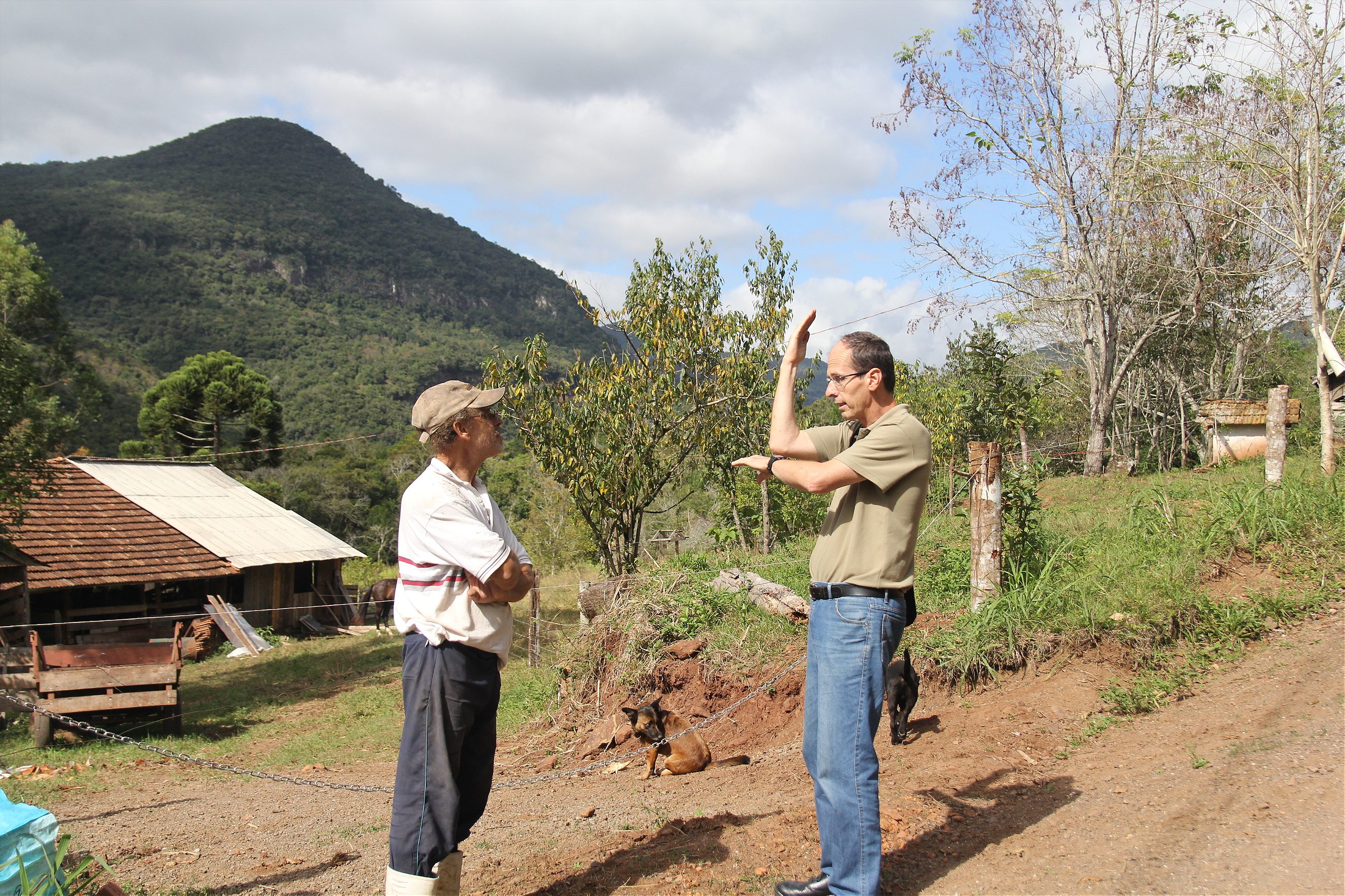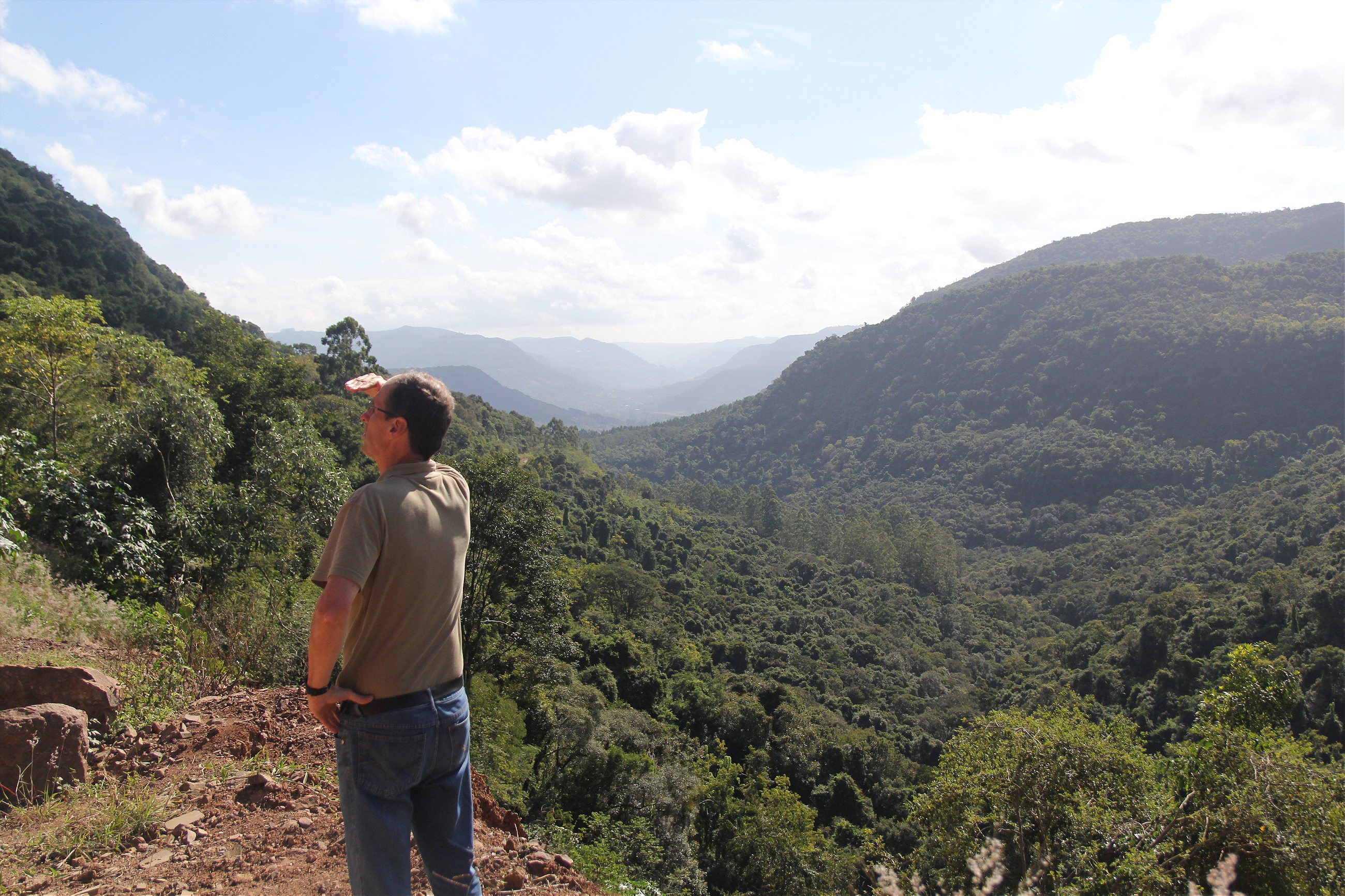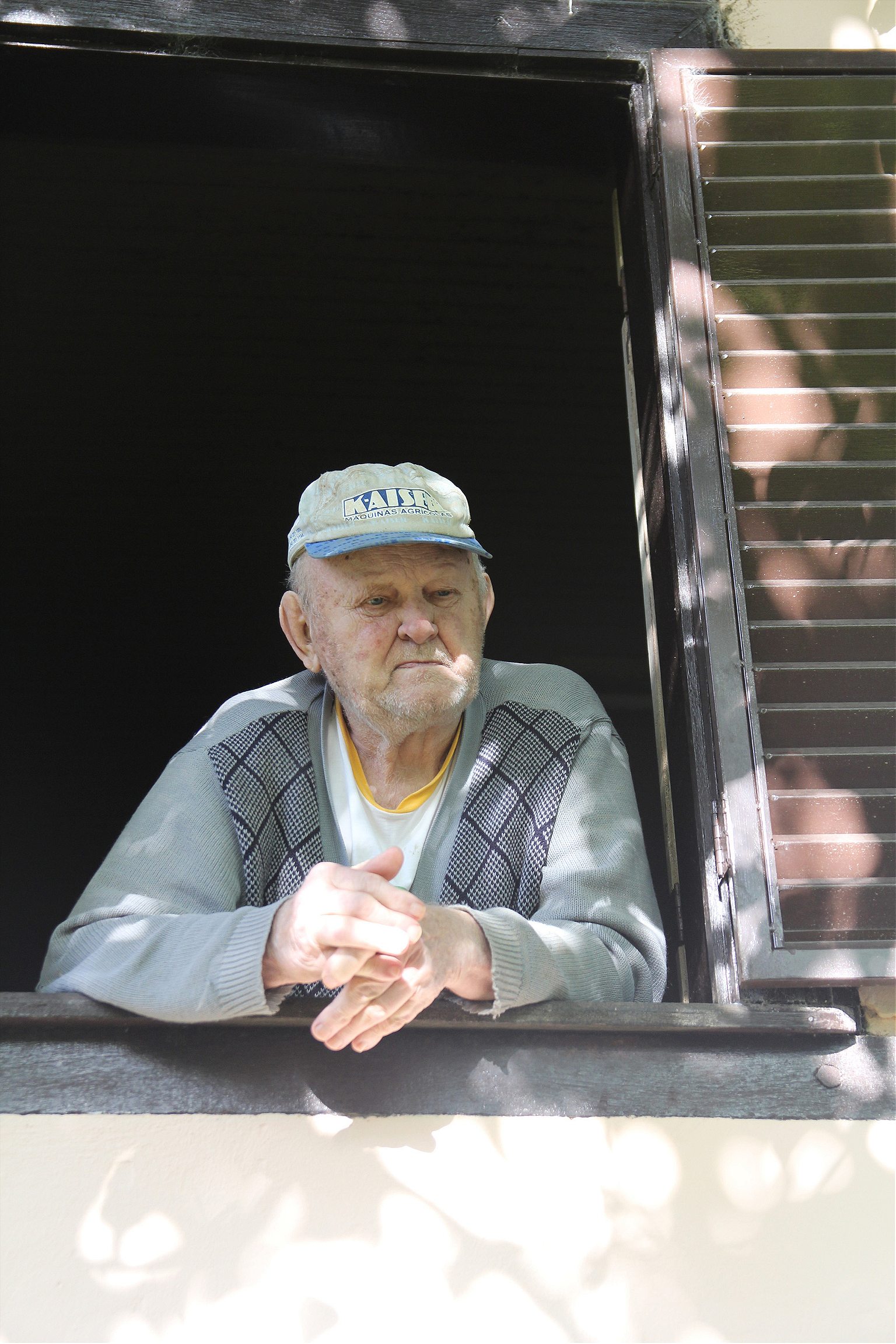Giant sloth burrows, obscure German dialects, and wild goose chases: just another day in the life of a shoe-leather speleologist.
Pulling his candy red Fiat to a stop along a narrow dirt road in southern Brazil’s Serra Gaúcha, Dr. Heinrich Frank grabs a business card from the stack he keeps in the dash and approaches a nearby farmer putt-putting along on a small, blue tractor.
“I’d like to ask you a strange question: Are there any caves around here?”
It is an opening gambit that Frank, a geologist at the Federal University of Rio Grande do Sul, is well used to uttering, and one that seemingly puts the farmer at ease.
Having previously eyed the visitor with the caution one might reserve for an unsolicited salesman, politician or religious fanatic, the farmer tells Frank all that he knows. He thinks there is some sort of cave high up on the mountain, overlooking the field. There is an old man who lives up there who would know more, he adds.
After taking the information down in a small pad, Frank bids a cheerful farewell and returns to his car. It is a decent lead; the morning is off to a good start for the cave hunter.
He’s completely stumped by how these caves came to be
Frank is on the prowl for undocumented cavities in in the jagged, jungly terrain of the Serra Gaúcha range. A few caves have already become bona-fide attractions, while others attract enough visitors that word of them eventually finds its way onto the internet.
But what Frank is looking for are hollows known only to Gaúcha locals. It is what brought him to the quiet valley, ready to pose his strange question—“any caves in these parts?”—to anyone he can find.
Such shoe-leather speleology led Frank here to Picada Café, a small municipality in the mountains about 40 miles north of Porto Alegre, the state capital of Rio Grande do Sul and home to the university where the geologist works.
Frank’s cave research suggested that the valley above Joaneta is terra incognita, begging to be explored.
Geologically speaking, it’s promising terrain. Many of the surrounding slopes feature cliffs made of rhyolite, a hard, igneous rock laid down somewhere around 130 million years ago. Beneath the cliffs, there is basalt, the result of a series of lava flows several million years earlier.
Where the two layers meet, Frank has been finding a curious sort of cave whose origins he has been unable to explain. They can be several hundred feet long, sometimes branching, sometimes rising and falling, sometimes decorated with unusual deposits and formations made of opal, notable because calcite deposits are what you’ll more commonly find in caves.
Frank has identified more than 20 caves that fit this pattern, and while he’s ruled out a number of explanations–dissolution, erosion, fracturing—he’s completely stumped by how they might have come to be.

For much of his free time, Frank is either hunting for such caves or tinkering around in ones he’s already found, all in the name of geological inquiry.
A hundred or so yards on from where the farmer set Frank on his way, the cave hunter comes to a stop at a house obscured by a large orange tree, heavy with ripe fruit, and patrolled by a barking dog.
A man on the front porch glances up from his newspaper with a familiar cautious look. It is back to the tried and tested routine for Frank, an offer of a business card then the question: “Heard of any caves around here?”
And it is the same desired result. The man relaxes and starts relaying what he knows as his wife wanders out to join the conversation. People love to talk about this stuff, Frank later remarks. He has never been treated rudely, nor has he ever been run off anyone’s lawn.
Frank first poses his question in Portuguese before doubling back in German: “Höhlen?”
Eyes tend to light up at the switch. “Ah, you speak German?” is a common response delivered in Hunsrik, a German dialect that is sort of like the Brazilian version of Pennsylvania Dutch.
Beginning in the 19th century, southern Brazil received hundreds of thousands of German immigrants. In this part of the Serra Gaúcha, they mostly came from Hunsrück mountains in what is now the German state of Rhineland-Palatinate. Today, around 1.2 million of their descendants speak Hunsrik, estimates Cleo Altenhofen, a linguist at the federal university in Porto Alegre, making it the most widely spoken of more than a dozen German dialects still spoken in Brazil.
Frank, whose mother was born in Germany, grew up speaking plain old German on the outskirts of Porto Alegre. If a colono, or “settler” as the people who live up in these mountains are called, gets too carried away in Hunsrik, Frank sometimes struggles to understand.
But with each answer, Frank inches closer to his goal. What begins with a vague, “I’ve heard there might be a cave over there somewhere,” gradually becomes more tangible with each person he speaks to, no matter the language.
Back on the hunt, Frank continues to chase down reports of a cave. “They say there is one, but I’ve never been there,” explains Antônio Roberto Holz, standing in the barnyard of a tiny mountain farm.
And so on down the road, seemingly getting closer and closer. Yes, there is definitely a cave nearby but I’ve never been in it, says a man from his porch. He adds that his neighbor has actually set foot in it.
Frank finds Antônio César do Carmo two houses up, pruning grape vines beside his barn. Do Carmo confirms that an actual cave actually exists on this very piece of property, and enthusiastically gives Frank permission to return to survey it at some point in the near future.

Frank leaves Do Carmo’s place in high spirits, having sniffed out a new cave and laid all the necessary groundwork to return to study it.
“That made the whole day worth it,” he says, zooming away in his Fiat.
Expeditions aren’t always so fruitful, as we find out after a $3 buffet lunch at a rice and beans place in Joaneta.
The afternoon hunt is a bust; no cave is located. But the trip isn’t a total washout. Rattling along in the Fiat, Frank suddenly slams on the brakes along a twisty dirt road and shouts triumphantly: “Paleoburrow.”
Geology isn’t the only source of cave formation in Serra Gaúcha; the region is also riddled with the handiwork of giant ground sloths and armadillos.
The animals went extinct somewhere around 10,000 years ago. But the burrows they dug–some of which are truly massive in scale–remain. For reasons still unknown, very few of these paleoburrows have been identified elsewhere in the world, despite the fact that the animals thought to have dug them spread far beyond what today is southern Brazil.
Frank, one of the world’s leading experts on paleoburrows, has identified well over 1,500 in Rio Grande do Sul.
He approaches the task of locating the animal burrows in a similar fashion to other caves: traversing the area, seeking out locals to pose the same question. He finds it’s best to not get into these caves’ sloth or armadillo origins: “If I start talking about extinct animals, they’ll think I’m really crazy.”
Frank very rarely finds paleoburrows in this part of the Serra Gaúcha, however, primarily because landslides and soil creep along its steep slopes have long since buried any burrows that may have existed in the mountains. But sometimes he gets lucky, and here, on the lonely road winding down a little valley drained by the Arroio Paixão—Passion Creek—a new paleoburrow has fallen into Frank’s lap.
By its relatively small size, he believes it’s the work of an extinct armadillo. The sloths were bigger; some of their burrows nearby are easily big enough to enter standing straight up and stretch back hundreds of feet. Often, as is the case today, the smaller burrows have filled in with sediment in the millennia since they were dug. Still, they stand out like knots in a board, different colored, roundish, with a different grain pattern. Sometimes, these burrows in roadcuts are still partially open. A few years ago, Frank found an open one in a recent excavation where a work crew was widening a highway. He wriggled into the narrow tube until it ended 65 feet inside the hill.
On this occasion, it’s just a few pictures and careful notes about the location, for entry later into his master list of paleoburrows. Smiling, he hops back in the car and resumes the hunt for the entirely different type of bizarre cave that brought him up here to the mountains.

Frank, one of the world’s leading experts on paleoburrows, has identified well over 1,500 in Rio Grande do Sul.
He approaches the task of locating the animal burrows in a similar fashion to other caves: traversing the area, seeking out locals to pose the same question. He finds it’s best to not get into these caves’ sloth or armadillo origins: “If I start talking about extinct animals, they’ll think I’m really crazy.”
Frank very rarely finds paleoburrows in this part of the Serra Gaúcha, however, primarily because landslides and soil creep along its steep slopes have long since buried any burrows that may have existed in the mountains. But sometimes he gets lucky, and here, on the lonely road winding down a little valley drained by the Arroio Paixão—Passion Creek—a new paleoburrow has fallen into Frank’s lap.
By its relatively small size, he believes it’s the work of an extinct armadillo. The sloths were bigger; some of their burrows nearby are easily big enough to enter standing straight up and stretch back hundreds of feet. Often, as is the case today, the smaller burrows have filled in with sediment in the millennia since they were dug. Still, they stand out like knots in a board, different colored, roundish, with a different grain pattern. Sometimes, these burrows in roadcuts are still partially open. A few years ago, Frank found an open one in a recent excavation where a work crew was widening a highway. He wriggled into the narrow tube until it ended 65 feet inside the hill.
On this occasion, it’s just a few pictures and careful notes about the location, for entry later into his master list of paleoburrows. Smiling, he hops back in the car and resumes the hunt for the entirely different type of bizarre cave that brought him up here to the mountains.

The day’s last stop is in a tiny speck of a place known as São José do Caí. Frank trades five or six business cards for blank looks from people who don’t seem to know anything or care much about caves, before finding his way to a simple house where an old man peers curiously out the window.
Eager to talk, he gives off the impression of someone who spends an awful lot of time staring out this window without much company.
Though wizened, the man seems entirely lucid, digressing into fond memories of life in the barracks back in the 1950s when he was in the military. After Frank steers him back on-topic, the man says no, there are no caves in São José do Caí. On this, he is emphatic. But he knows exactly how to get to one close by.
Frank pulls his notebook and begins scribbling down the details: Go back to the main road, turn left toward Nova Petrópolis, go three kilometers, look for the blue house on the right, park there, follow a path about 300 meters up away from the road. There’s a big cave there, seven or eight meters deep, big enough to walk into. A detailed, surefire description if there ever was one.

After drawn-out “goodbyes” and “thank yous,” slipping as always from Portuguese to Hunsrik and back again, Frank points the Fiat back toward the pavement, hangs a left and ascends with an eye on the odometer. At three kilometers, there is no blue house on the right, nor any house of any color anywhere in sight. Four kilometers pass, then five, with nothing but heavy forest. Very strange, mutters Frank, very strange.
Another mile or two, and when the forest gives way to the town of Nova Petrópolis, it is clear that the cave described in such detail by the old man isn’t going to materialize today. Maybe he meant turn right instead of left on the main road, Frank speculates. Who knows. Whereas the morning’s cave hunt was a smash success; the afternoon concludes with a wild goose chase.